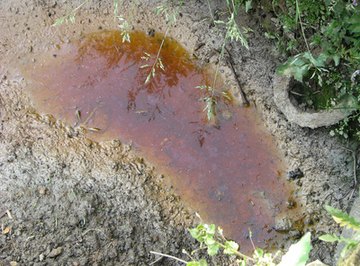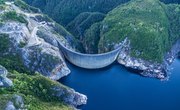
According to NASA, 70 percent of the Earth’s surface is water, yet only 2.5 percent of it is actually safe for humans and animals to drink. With so little of the global water supply potable, an abundance of waterborne pollutants could be catastrophic. There are several different types of pollutants that can enter a water source, and in a number of different ways.
Sewage
Sewage is human and animal waste primarily made up of fecal matter and other organic materials, as well as discarded inorganic waste. Sewage can enter a water system in a variety of ways: from a gutter along with rainwater, which is called urban runoff; from inadequate septic system or septic leach lines; and from faulty public sewage facilities. Sewage can generate a high concentration of pathogenic microorganisms including harmful bacteria such as Escherichia coli, commonly referred to as E. coli. Once sewage is introduced into a water system, it can quickly make its way into lakes, rivers, aquifers and streams, and eventually into drinking water.
Fertilizers
Farmers and ranchers use fertilizers to enrich the soil with nutrients plants need to grow. Many fertilizers can contain natural chemical compounds such as phosphates and nitrates. When these chemicals infiltrate a water system in vast quantities, they can upset the natural balance of these elements, creating an environment ideal for an overpopulation of algae. The aquatic system becomes polluted when these overabundant algae decrease the oxygen and cloud the water. Fertilizers can enter a major waterway through agriculture runoff by way of field canals.
Eutrophication
Eutrophication is pollution caused when soil sediments such as silt and other organic matter such as dead plants, leaves and grasses slowly enter a water system through erosion or natural forces. The organic material builds up in ponds, lakes, rivers and streams. The matter gradually fills the body of water until it can no longer sustain enough light and oxygen for aquatic plants. The water also becomes inundated with high levels of nutrients.
Once the aquatic system becomes eutrophic with nutrients, excessive amounts of algae begin to grow, which also causes a decrease in oxygen. Eutrophication can also clog water inlets and outlets, essentially cutting the natural flow of fresh water and creating a stagnant bog or lifeless pool.
References
Resources
About the Author
Christa Kerley has a B.A. in anthropology with emphasis in archaeology. She also has certificates in geographic information systems and cultural resource management. Kerley was author and distributor of a nonfiction newsletter for several years, and has worked since 1997 as a freelance copywriter and research writer. Some of Kerley's published works can be viewed at eHow, Bukisa, Suddenlyslim.net, Answerbag, and Pluck on Demand.
Photo Credits
pollution 1 image by Nathalie P from Fotolia.com
